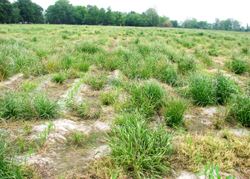MSU Scientists Battle Herbicide Resistance
|
STONEVILLE, MISS.
Mississippi State University scientists are leading the charge in the fight against glyphosate-resistant Italian ryegrass with a research-based plan of attack.
Jason Bond, a weed scientist at the MSU Delta Research and Extension Center in Stoneville, said Mississippi was the first state to discover Italian ryegrass that cannot be controlled with glyphosate, a common herbicide originally known as Round-up, in a crop situation. The weed has spread quickly since it arrived.

Mississippi State University weed scientists are leading the fight against glyphosate-resistant Italian ryegrass, such as this growing in a production corn field in Washington County in early spring 2013.
Photo by MSU Delta Research and Extension Center/Jason Bond
“We have 32 counties that contain glyphosate-resistant Italian ryegrass,” Bond said. “The state with the next highest amount is Arkansas, and they have eight counties with this problem. We’ve been working on this challenge since 2005, and everyone is looking to Mississippi for recommendations.”
Bond said he and his colleagues with the Mississippi Agricultural and Forestry Experiment Station and the MSU Extension Service are very confident about the effectiveness of the research-based program they developed to control glyphosate-resistant Italian ryegrass. It is based on the use of other types of herbicide applied at specific times.
“Our program requires a minimum of two herbicide applications to even approach complete control,” he said. “Ideally, growers will use fall, winter and spring herbicide applications for total control.”
Bond said growers should make the first herbicide application in fall, from mid-October to mid-November; the second in winter, from mid-January to early February; and the third in spring, around March 1.
“Many of our Delta growers already use post-harvest herbicides in the fall,” he said. “They do a lot of tillage after harvest and don’t want to disturb the fields before they plant, so they put down an herbicide to control winter vegetation. That practice isn’t typical in other states, so some growers hesitate to invest in that application. But to control glyphosate-resistant Italian ryegrass, they need to put down a residual herbicide to control it before it comes up.”
Bond said growers who do not take steps in the fall to control glyphosate-resistant Italian ryegrass find it more difficult to control later. He and his colleagues have tested a variety of factors to develop their approach.
“We’ve sprayed around 50 residual herbicides to test their effectiveness, and we’ve found five or six that are active against glyphosate-resistant Italian ryegrass,” he said. “We haven’t kept track of post-emergence herbicides we’ve tried, but I’d guess easily over 100. Basically, at one time or another, we have sprayed every herbicide with any activity on grass species that is labeled for use in corn, rice, cotton or soybean.”
Once Bond and his colleagues developed their recommendations and collected more data to verify their approach worked, they tackled the research from a yield perspective.
They began with test plots: some were free of ryegrass; some had been treated with two to three herbicide applications; and some were not treated at all and were carpeted with ryegrass.
“We applied different levels of our herbicide program and planted corn, cotton or soybeans,” he said.
Then they monitored the yields from each test plot to see how the invasive weed impacted production.
In 2012, MSU researchers found corn was the most susceptible to yield reduction because of uncontrolled glyphosate-resistant Italian ryegrass.
“When we controlled glyphosate-resistant Italian ryegrass in corn, the benefit-to-cost ratio was 13:1,” he said. “For every dollar spent to control glyphosate-resistant Italian ryegrass, we received a $13 return in corn yield. Even if that was only 2:1, the inputs still paid for themselves.”
Unfortunately for growers, Italian ryegrass is not the only glyphosate-resistant weed they have to manage.
Mississippi has the dubious honor of having more documented glyphosate-resistant weed species than any other state. While new control technologies are on the horizon, for now, growers must battle some type of weed year-round.
Darrin Dodds, cotton specialist with the Mississippi State University Extension Service, said each year more weeds are identified as resistant to herbicides.
“Mississippi has had documented resistance to herbicides as far back as 1989, when common cocklebur was identified as being resistant to a certain class of herbicides,” Dodds said. “But beginning in 2003, the number of weeds resistant to glyphosate began steadily increasing: horseweed in 2003; Italian ryegrass in 2005; Palmer amaranth in 2009; johnsongrass, common waterhemp, and giant ragweed in 2010; and goosegrass and spiny amaranth in 2012.
“Mississippi row crop producers need to be as adaptable as the weeds they fight, because herbicide-resistant weeds are here to stay,” he said.
For herbicide program information, visit http://msucares.com and click on “Insects-Plant Diseases-Pesticides-Weeds” or download Publication 1532, “2013 Weed Control Guidelines for Mississippi.” Information can also be found at the Mississippi Crop Situation Blog, http://www.mississippi-crops.com.∆ |
|
|
|